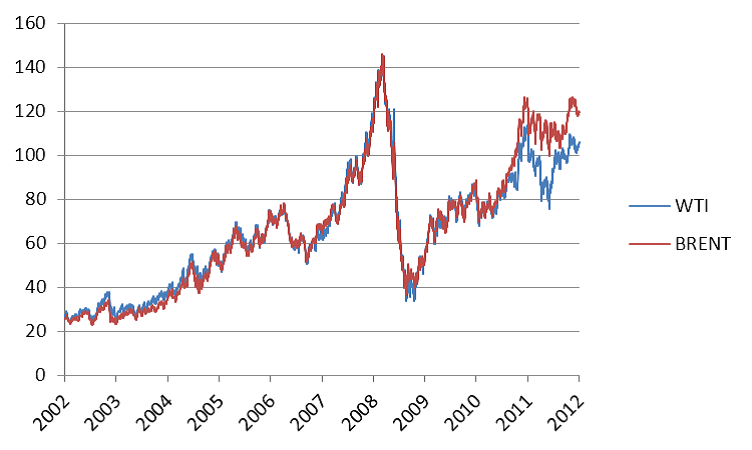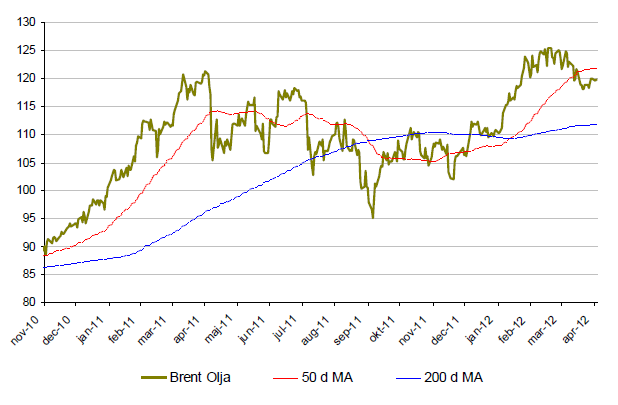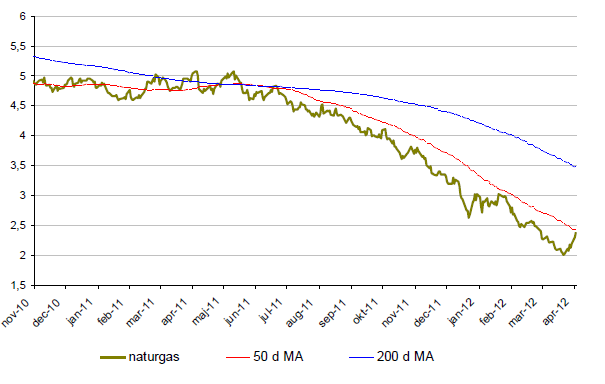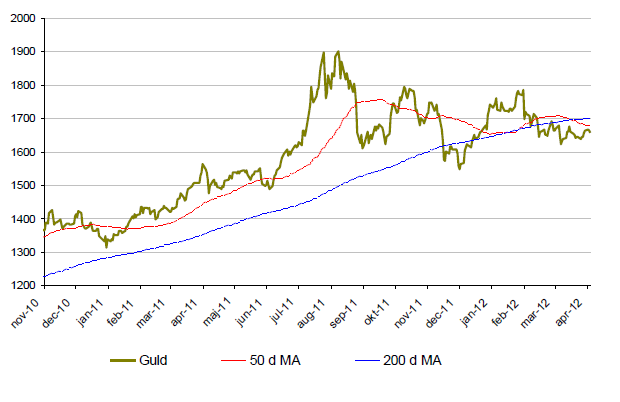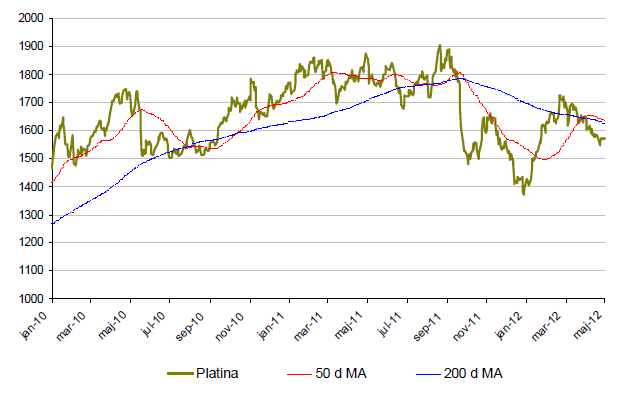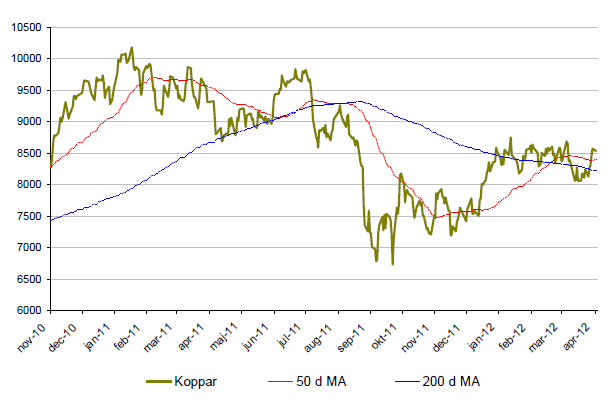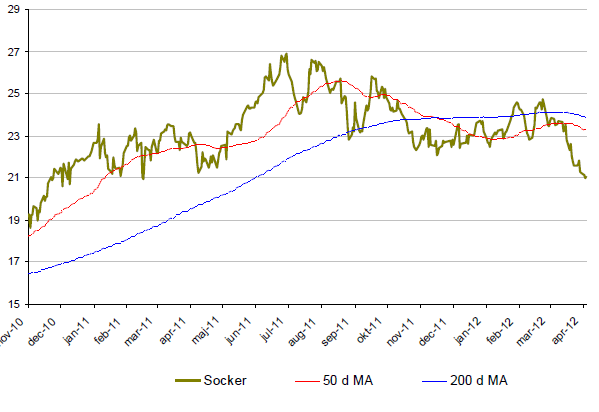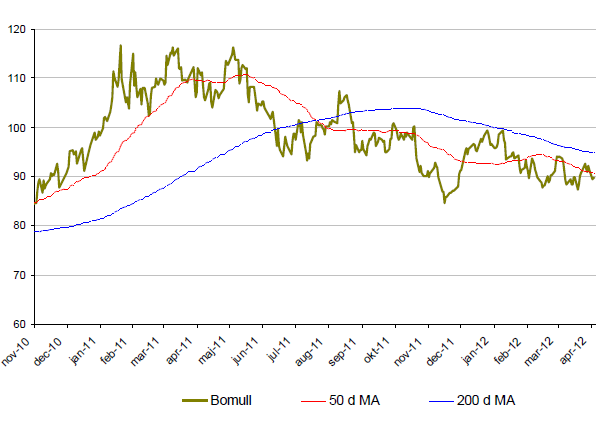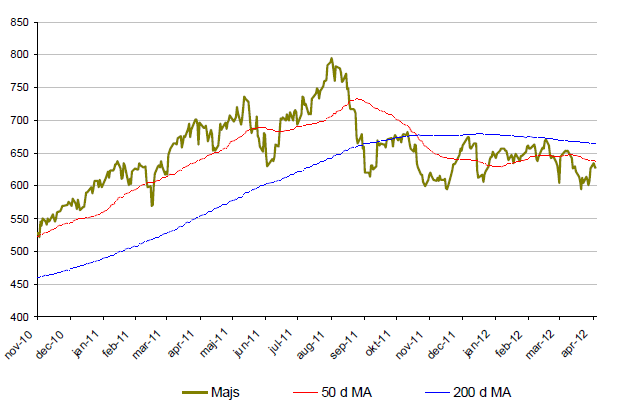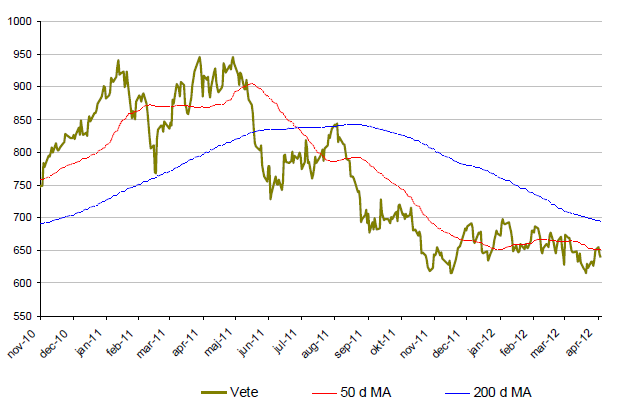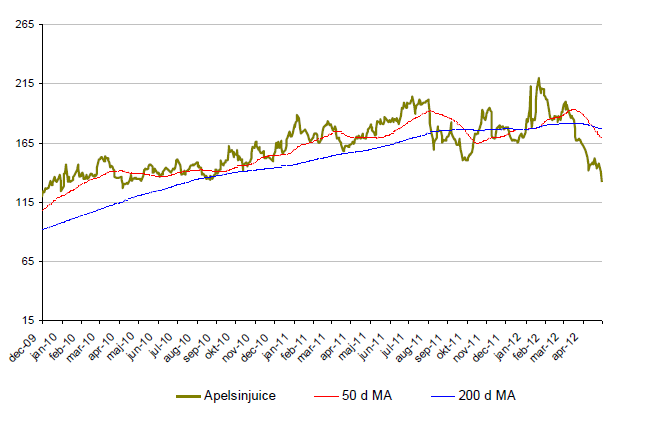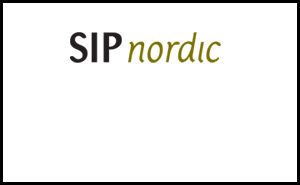Analys
SIP Nordic – Råvaruguiden – maj 2012
 Söta, lätta och lika svarta – ändå så olika
Söta, lätta och lika svarta – ändå så olika
När medier rapporterar om oljepriset säger de oftast just olja. Vad de missar är att det finns över 160 olika oljesorter som handlas på olika råvarumarknader. Nu är det ju självklart så att vi vanliga spekulanter inte kan investera i alla dessa 160 oljetyper. Vi har vanligtvis två val. WTI-oljan eller Brent-oljan. De är båda svarta till färgen, kallas söta och lätta men priset skiljer sig nu mer än vanligt.
Vad som skiljer de olika oljetyperna åt och som till stor del genererar prisskillnaderna mellan dessa är dess egenskaper och kvalité. Olja med bättre kvalité bör under normala marknadsförhållanden kosta mer än den med sämre kvalité.
WTI och Brent vanligast
 De två mest handlade oljetyperna är WTI- och Brent-oljan. Båda WTI och Brent är med sina relativt låga densiteter så kallade lätta (light) oljor. WTI är något lättare än Brent. Dessutom är svavelnivåerna i oljorna lägre än 0,5 % vilket klassificerar dem som söta (sweet). Återigen är WTI- oljan något bättre än Brent-oljan även i detta avseende.
De två mest handlade oljetyperna är WTI- och Brent-oljan. Båda WTI och Brent är med sina relativt låga densiteter så kallade lätta (light) oljor. WTI är något lättare än Brent. Dessutom är svavelnivåerna i oljorna lägre än 0,5 % vilket klassificerar dem som söta (sweet). Återigen är WTI- oljan något bättre än Brent-oljan även i detta avseende.
Dessa två egenskaper gör att WTI-oljan anses vara av bättre kvalité än Brent-oljan. Historiskt sett handlas även WTI-oljan till ett högre pris än Brent-oljan. De senaste åren handlas dock Brent-oljan till ett högre pris än WTI-oljan.
Ökade lager i USA och oroligheter i mellanöstern
Priset på WTI-oljan, som framförallt raffineras i USA och den mexikanska golfen, reflekteras ofta i tillgångs- och efterfrågebalansen på den amerikanska och kanadensiska marknaden. Brent-oljan, som är en kombination av olika oljor från 15 olika oljefält i Nordsjön, tenderar å andra sidan att styras mer av den globala tillgångs- och efterfrågebalansen. Dessutom tenderar Brent att påverkas mer av de oroligheterna vi sett i mellanöstern den senaste tiden.
WTI-oljan har historiskt sett handlats runt $2 dyrare än Brent. Det senaste tidens oroligheter i mellanöstern och ökade lagerstatistik i USA har dock resulterat i att Brent-oljan kostat så mycket som $25 dollar mer än WTI.
Råvaror – Energi
Brent olja
- Olja är upp ca.11 % upp för året.
- Under april månad har dock Brent-oljan tappat 3 %.
- Det finns idag ingen riktigt tydlig kortsiktig riktning för Brent-oljan. Upp på längre sikt.
- Lagernivåerna spås öka under Q2, dock från låga nivåer vilket är en följd av ökad produktion från OPEC-länderna och säsongsrelaterade minskningar i efterfrågan.
- Trots detta kan priset på olja fortsätta ligga på dessa nivåer till följd av att OPEC-ländernas produktion används för att täcka bortfall av Iransk olja.
Naturgas
- Naturgas har under april månad utvecklats väl. För månaden upp ca 6 %.
- Sista veckan i april gick naturgas upp över 20 %.
- Trots detta ligger naturgas på historiskt låga nivåer.
- Varma temperaturer i framförallt USA bidrar till minskad efterfrågan vilket har påverkat priset negativt under året.
- Lagren av naturgas väntas öka under 26 %.
- Priset är nu så pass lågt att producenter kan tvingas minska produktionen. Ett sådant stopp kan få priset att studsa upp.
Råvaror – Metaller
Guld
- Guld har under april månad tappat ca en halv procent. För året är guld upp 7 %
- Reuters publicerade i april sin guldundersökning. Där förutspås en guldkurs som fluktuerar i ett stort spann men som ligger något över dagens nivåer vid årets slut.
- I undersökningen tas det även upp att centralbankerna fortsätter att öka sitt guldinnehav under 2012. De justerar även den tidigare prognosen om 300 ton nettoinflöde till 400 ton.
- Det skrivs också om fallande guldpriser under 2013 till följd av stabilare globalt marknadsläge.
Silver
- Silver har i år gått upp med ca 15 %. Under april månad har dock priset på silver backat med ca 5 %
- Silver befinner sig fortsatt i en långsiktigt fallande kil.
- Tillgången på silver väntas minska med 1,5 % samtidigt som efterfrågan endast spås öka med 0,3 %. Trots detta är tillgången på silver god.
- Den europiska kreditkrisen i kombination med rädsla för minskad kinesisk tillväxt bidrar till de negativa sentimenten i silver.
Platina
- För året är platina upp ca 13,5%.
- Under april månad har platina tappat 4,7 %
- Nedgången gör att platina nu återigen handlas till en billigare kurs än guld.
- Platinatillgången spås öka med 3 % under 2012 samtidigt som konsumtionen endast väntas öka med 2 %. Detta gör att skillnaden mellan tillgång och efterfrågan väntas öka med ca 12 %.
- Rädsla för en fördjupad europeisk kris i kombination med en rädsla för mindre kinesisk tillväxt pressar platinapriset.
Koppar
- Koppar har börjat året starkt efter ett ur svagt 2011. Koppar har gått upp ca 12,5% i år. (Att jämföra med -21 % under 2011)
- Under april månad har dock kopparpriset stagnerat och är upp 0,5 %.
- Siffror visar att världens största konsument av koppar, Kina, under mars månad importerade över 480 tusen ton. Den fjärde högsta siffran någonsin.
- Kopparinventarierna ligger på låga nivåer och lagren av koppar räcker endast i tre veckor.
- Samma siffra väntas sjunka till 2.8 under 2013 vilket kan pressa kopparpriset trots rädsla för en avsvalnad kinesisk tillväxt.
Zink
- Likt koppar har zinkpriset kraftigt stigit under den första månaden av 2012. Zink är upp ca 11 % för året.
- Zinkprisets har trots en mer sund balans i tillgång och efterfrågan gått upp ca 1,5 % under april månad.
- Den årliga konsumtionen av zink förväntas växa med 3.6% samtidigt som tillgången bara förväntas växa med 3 %. Det uppskattas dock att nuvarande zinktillgång skulle räcka 7,5 veckor, 0,5 veckor längre än 2011.
Nickel
- Nickel presterade sämst av alla basmetaller under 2011.
- Nickel fortsätter sin kräftgång under 2012. Efter en uppgång i januari tappade nickel närmare 18 % under februari och mars och är nu den enda basmetallen som inte utvecklats positivt under 2012.
- Produktionen väntas överstiga konsumtionen under 2012. Mängden tillgänglig nickel väntas dock minska under 2013 och i kombination med ett bättre marknadsläge spår analytikerna ett högre nickelpris under 2013.
- Nuvarande nickelnivåer räcker för 10,4 veckors konsumtion. Ca en vecka högre än 2011.
Råvaror – Jordbruk
Socker
- Socker startade året starkt till följd av dåliga och torra väderförhållandena i världens största sockerproducerande land, Brasilien.
- Sedan mars faller dock socker kraftigt. Indien producerar och exporterar socker i hög fart vilket resulterat i att socker under mars-april tappat nästan 16 %.
- Genomsnittspositionen är fortsatt lång men säljarna börjar nu bli fler och fler.
Bomull
- Bomull är för året ned ca 4 %
- Under 2012 har säljarna kopplat greppet om bomull.
- Exporten från Indien väntas öka under året. Dessutom visar siffror att produktionen av bomull i USA väntas vara högre än beräknat.
- Den kinesiska efterfrågan på bomull har under april månad avtagit.
Majs
- Majspriset är i stort sett oförändrat för året. (+1%)
- Majs pendlar mellan 600 och 660 cents.
- Väderförhållanden i USA är goda inför den majs som sättas och skördas under våren.
- Statistik som visar USA-exporten av majs ökar kraftigt. Kina importerar nu rekordstora mängder majs.
- En ökad efterfrågan neutraliseras av goda väderförhållanden vilket gör att det inte finns en tydlig trend i majs.
Vete
- Antalet spekulanter som tror på nedgång fortsätter att växa.
- För året är vete i det närmaste oförändrat.
- Priset pendlar nu mellan 620 och 660.
- Anledningen till att vetekursen konsoliderar är att USDAs lagerstatistik om ökade lager neutraliseras av dåliga väderförhållanden i östeuropeiska länder.
Apelsinjuice
- Priset på apelsinjuice fortsätter att falla som en sten.
- Sedan toppen den 19 januari har apelsinjuice nu tappat över 30 %.
- Det finns fortfarande fallhöjd i kursen då apelsinjuice har stigit med nästan 113 % sedan 2009.
- Skörden spås dock bli väldigt god i Florida samtidigt som rapporter visar att efterfrågan på apelsinjuice minskar vilken kyler av priset.
- Skörden för året spås bli mycket högre än förra året.
[box]Denna uppdatering är producerat av SIP Nordic och publiceras i samarbete och med tillstånd på Råvarumarknaden.se[/box]
Ansvarsbegränsning
Detta produktblad utgör endast marknadsföring och har sammanställts av SIP Nordic Fondkommission AB.
Innehållet ger inte fullständig information avseende det finansiella instrumentet. Investerare uppmanas att del av prospekt och slutliga villkor, vilka finns tillgängliga på: www.rbsbank.se/markets, innan ett investeringsbeslut tas.
Förekommande exempel är simulerade och baseras på SIP Nordics egna beräkningar och antaganden, en person som använder andra data eller antaganden kan nå andra resultat. Administrativa avgifter och transaktionsavgifter påverkar den faktiska avkastningen.
Analys
Tightening fundamentals – bullish inventories from DOE

The latest weekly report from the US DOE showed a substantial drawdown across key petroleum categories, adding more upside potential to the fundamental picture.

Commercial crude inventories (excl. SPR) fell by 5.8 million barrels, bringing total inventories down to 415.1 million barrels. Now sitting 11% below the five-year seasonal norm and placed in the lowest 2015-2022 range (see picture below).
Product inventories also tightened further last week. Gasoline inventories declined by 2.1 million barrels, with reductions seen in both finished gasoline and blending components. Current gasoline levels are about 3% below the five-year average for this time of year.
Among products, the most notable move came in diesel, where inventories dropped by almost 4.1 million barrels, deepening the deficit to around 20% below seasonal norms – continuing to underscore the persistent supply tightness in diesel markets.
The only area of inventory growth was in propane/propylene, which posted a significant 5.1-million-barrel build and now stands 9% above the five-year average.
Total commercial petroleum inventories (crude plus refined products) declined by 4.2 million barrels on the week, reinforcing the overall tightening of US crude and products.


Analys
Bombs to ”ceasefire” in hours – Brent below $70

A classic case of “buy the rumor, sell the news” played out in oil markets, as Brent crude has dropped sharply – down nearly USD 10 per barrel since yesterday evening – following Iran’s retaliatory strike on a U.S. air base in Qatar. The immediate reaction was: “That was it?” The strike followed a carefully calibrated, non-escalatory playbook, avoiding direct threats to energy infrastructure or disruption of shipping through the Strait of Hormuz – thus calming worst-case fears.

After Monday morning’s sharp spike to USD 81.4 per barrel, triggered by the U.S. bombing of Iranian nuclear facilities, oil prices drifted sideways in anticipation of a potential Iranian response. That response came with advance warning and caused limited physical damage. Early this morning, both the U.S. President and Iranian state media announced a ceasefire, effectively placing a lid on the immediate conflict risk – at least for now.
As a result, Brent crude has now fallen by a total of USD 12 from Monday’s peak, currently trading around USD 69 per barrel.
Looking beyond geopolitics, the market will now shift its focus to the upcoming OPEC+ meeting in early July. Saudi Arabia’s decision to increase output earlier this year – despite falling prices – has drawn renewed attention considering recent developments. Some suggest this was a response to U.S. pressure to offset potential Iranian supply losses.
However, consensus is that the move was driven more by internal OPEC+ dynamics. After years of curbing production to support prices, Riyadh had grown frustrated with quota-busting by several members (notably Kazakhstan). With Saudi Arabia cutting up to 2 million barrels per day – roughly 2% of global supply – returns were diminishing, and the risk of losing market share was rising. The production increase is widely seen as an effort to reassert leadership and restore discipline within the group.
That said, the FT recently stated that, the Saudis remain wary of past missteps. In 2018, Riyadh ramped up output at Trump’s request ahead of Iran sanctions, only to see prices collapse when the U.S. granted broad waivers – triggering oversupply. Officials have reportedly made it clear they don’t intend to repeat that mistake.
The recent visit by President Trump to Saudi Arabia, which included agreements on AI, defense, and nuclear cooperation, suggests a broader strategic alignment. This has fueled speculation about a quiet “pump-for-politics” deal behind recent production moves.
Looking ahead, oil prices have now retraced the entire rally sparked by the June 13 Israel–Iran escalation. This retreat provides more political and policy space for both the U.S. and Saudi Arabia. Specifically, it makes it easier for Riyadh to scale back its three recent production hikes of 411,000 barrels each, potentially returning to more moderate increases of 137,000 barrels for August and September.
In short: with no major loss of Iranian supply to the market, OPEC+ – led by Saudi Arabia – no longer needs to compensate for a disruption that hasn’t materialized, especially not to please the U.S. at the cost of its own market strategy. As the Saudis themselves have signaled, they are unlikely to repeat previous mistakes.
Conclusion: With Brent now in the high USD 60s, buying oil looks fundamentally justified. The geopolitical premium has deflated, but tensions between Israel and Iran remain unresolved – and the risk of missteps and renewed escalation still lingers. In fact, even this morning, reports have emerged of renewed missile fire despite the declared “truce.” The path forward may be calmer – but it is far from stable.
Analys
A muted price reaction. Market looks relaxed, but it is still on edge waiting for what Iran will do

Brent crossed the 80-line this morning but quickly fell back assigning limited probability for Iran choosing to close the Strait of Hormuz. Brent traded in a range of USD 70.56 – 79.04/b last week as the market fluctuated between ”Iran wants a deal” and ”US is about to attack Iran”. At the end of the week though, Donald Trump managed to convince markets (and probably also Iran) that he would make a decision within two weeks. I.e. no imminent attack. Previously when when he has talked about ”making a decision within two weeks” he has often ended up doing nothing in the end. The oil market relaxed as a result and the week ended at USD 77.01/b which is just USD 6/b above the year to date average of USD 71/b.

Brent jumped to USD 81.4/b this morning, the highest since mid-January, but then quickly fell back to a current price of USD 78.2/b which is only up 1.5% versus the close on Friday. As such the market is pricing a fairly low probability that Iran will actually close the Strait of Hormuz. Probably because it will hurt Iranian oil exports as well as the global oil market.
It was however all smoke and mirrors. Deception. The US attacked Iran on Saturday. The attack involved 125 warplanes, submarines and surface warships and 14 bunker buster bombs were dropped on Iranian nuclear sites including Fordow, Natanz and Isfahan. In response the Iranian Parliament voted in support of closing the Strait of Hormuz where some 17 mb of crude and products is transported to the global market every day plus significant volumes of LNG. This is however merely an advise to the Supreme leader Ayatollah Ali Khamenei and the Supreme National Security Council which sits with the final and actual decision.
No supply of oil is lost yet. It is about the risk of Iran closing the Strait of Hormuz or not. So far not a single drop of oil supply has been lost to the global market. The price at the moment is all about the assessed risk of loss of supply. Will Iran choose to choke of the Strait of Hormuz or not? That is the big question. It would be painful for US consumers, for Donald Trump’s voter base, for the global economy but also for Iran and its population which relies on oil exports and income from selling oil out of that Strait as well. As such it is not a no-brainer choice for Iran to close the Strait for oil exports. And looking at the il price this morning it is clear that the oil market doesn’t assign a very high probability of it happening. It is however probably well within the capability of Iran to close the Strait off with rockets, mines, air-drones and possibly sea-drones. Just look at how Ukraine has been able to control and damage the Russian Black Sea fleet.
What to do about the highly enriched uranium which has gone missing? While the US and Israel can celebrate their destruction of Iranian nuclear facilities they are also scratching their heads over what to do with the lost Iranian nuclear material. Iran had 408 kg of highly enriched uranium (IAEA). Almost weapons grade. Enough for some 10 nuclear warheads. It seems to have been transported out of Fordow before the attack this weekend.
The market is still on edge. USD 80-something/b seems sensible while we wait. The oil market reaction to this weekend’s events is very muted so far. The market is still on edge awaiting what Iran will do. Because Iran will do something. But what and when? An oil price of 80-something seems like a sensible level until something do happen.
-

 Nyheter4 veckor sedan
Nyheter4 veckor sedanStor uppsida i Lappland Guldprospekterings aktie enligt analys
-

 Nyheter4 veckor sedan
Nyheter4 veckor sedanSilverpriset släpar efter guldets utveckling, har mer uppsida
-

 Nyheter3 veckor sedan
Nyheter3 veckor sedanUppgången i oljepriset planade ut under helgen
-

 Nyheter3 veckor sedan
Nyheter3 veckor sedanLåga elpriser i sommar – men mellersta Sverige får en ökning
-

 Nyheter2 veckor sedan
Nyheter2 veckor sedanMahvie Minerals växlar spår – satsar fullt ut på guld
-

 Analys3 veckor sedan
Analys3 veckor sedanVery relaxed at USD 75/b. Risk barometer will likely fluctuate to higher levels with Brent into the 80ies or higher coming 2-3 weeks
-

 Nyheter1 vecka sedan
Nyheter1 vecka sedanOljan, guldet och marknadens oroande tystnad
-

 Nyheter1 vecka sedan
Nyheter1 vecka sedanJonas Lindvall är tillbaka med ett nytt oljebolag, Perthro, som ska börsnoteras


